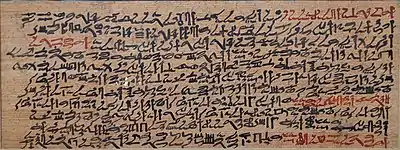Prisse Papyrus
The Prisse Papyrus is an ancient Egyptian papyrus datable to the Middle Kingdom[1]: 129 which was discovered by the inhabitants of Kurna and given to French orientalist Émile Prisse d'Avennes at Thebes and published in 1847 and is now in the Bibliothèque nationale de France in Paris.[1]: 129
Inhabitants of Kurna originally found the papyrus inside the rishi coffin of pharaoh Sekhemre-Wepmaat Intef of the 17th Dynasty, whose tomb was probably located in Dra' Abu el-Naga' near Thebes.[2]: 67

The papyrus document contains the last two pages of the Instructions of Kagemni, who purportedly served under pharaoh Sneferu of the 4th Dynasty, and is a compilation of moral maxims and admonitions on the practice of virtue (sebayt). The conclusion of the Instructions of Kagemni is followed by the only complete surviving copy of the Instruction of Ptahhotep.[3][4][5][6]
See also
References
- Simpson, William K. (1972). Simpson, William Kelly (ed.). The Literature of Ancient Egypt: An Anthology of Stories, Instructions, and Poetry. translations by R.O. Faulkner, Edward F. Wente, Jr., and William Kelly Simpson. New Haven and London: Yale University Press. ISBN 0-300-01711-1.
- Hayes, William C. (1973). "Egypt: from the death of Ammenemes III to Seqenenre II". In Edwards, I.E.S.; Gadd, C.J.; Hammond, N.G.L.; Sollberger, E. (eds.). The Cambridge Ancient History, vol. II, part 1. Cambridge University Press. pp. 42–76. ISBN 0-521-082307.
- Miriam Lichtheim, Ancient Egyptian Literature, Volume I, 1973, p.59
- Z.Zába (1956) retrieved 11:20GMT 24/9/11
- papyrus "Prisse" JW Bone (1887)
- Battiscombe Gunn, "THE WISDOM OF THE EAST, THE INSTRUCTION OF PTAH-HOTEP AND THE INSTRUCTION OF KE'GEMNI: THE OLDEST BOOKS IN THE WORLD", LONDON, JOHN MURRAY, ALBEMARLE STREET, 1906, https://www.gutenberg.org/files/30508/30508-h/30508-h.htm
Literature
- The Instruction addressed to Kagemni in M. Lichtheim, Ancient Egyptian Literature, Volume I, 1973, pp.59ff.
- The Instruction of Ptahhotep in M. Lichtheim, Ancient Egyptian Literature, Volume I, 1973, pp. 61ff.
- "Papyrus Prisse" by Franz Joseph Lauth retrieved 10:53 24/9/11
- papyrus "Prisse" JW Bone (1887) retrieved 11:34GMT 24/9/11
- text written-Isaac Meyer retrieved 13:36GMT 25.9.11